This is why your cat attacks. This post is everything we have learned through our own experiences of owning cats. We have received a lot of information from vets and behavioural specialists in the past. Our hope is that by writing it all down here that we can help other cat owners to fix their cats behavioural problems.
In this post I will tell you the reasons why your cat may show you aggressive behaviour. The ways in which this aggression may present itself. Also I will let you know some ways that you can take action to curb the aggression and so ultimately make your cat content and happy again.
Why does my cat attack me?
Why your cat attacks you? For many people, cats are the perfect pet. They are often independent, ideal for people who appreciate company and companionship but who don’t have the time to devote many hours per day in attention to the pet.
While owning a cat is a pleasant experience for many pet owners, there are times when problems arise. If a cat turns aggressive and attacks the owner or someone else in the home, it can leave the cat owner with a lot to think about.
A change in behaviour can be unpleasant for the owner to contend and cats can cause serious injuries when they act aggressively. Most pet owners will want to determine why their cat is now acting aggressively and determine what action they can take to remove this aggression from their domestic cat.
What causes aggression in domestic cats?
If a domestic cat has been well behaved and then suddenly becomes aggressive and causes harm, it is perfectly natural to assume that something has changed in the cat’s life or outlook. If a person behaved well and then suddenly became aggressive and dangerous, you would look for reasons for this change in behaviour, and the same approach should be taken with cats.
There are many different reasons and factors to consider why a cat becomes aggressive. As a starting point, it is helpful to consider the brief period prior to the cat becoming aggressive. While there may be long-term issues as to why a cat has turned aggressive, often it is down to an incident and the cat is responding with aggression to this incident.
Therefore, try to consider where the cat was and what happened to the cat just before they acted aggressively.
Fear aggression.
Why your cat attacks you, because of fear? One common reason for cats acting aggressively is fear. If a cat feels that they are being threatened or that they are in a situation they are unable to get out of, they may turn aggressive. This may be something that relates to the cat’s history or previous situations they have been in.
While the current situation that the cat is in may not seem too aggressive or challenging from the owner’s point of view, the cat may have a different viewpoint, especially if they had difficult experiences in a similar style in the past.
A medical reason for the aggression.
Why your cat attacks you, a medical reason? It is also common for cats to act aggressively due to a medical reason. When a cat is in pain, they may turn to aggression to protect themselves or as a way of acting out relating to the injury or pain they experience.
This form of aggression is common in older cats who had not shown any signs of aggression until now. Some of the most common ailments that can cause a cat to feel pain include:
To understand what the cat is going through, you only have to think about your own behaviour or reaction if you are in pain and you are touched or concerned that you may be touched in an area where you may feel pain.
It would be natural for a person to lash out at this time, and the same response is not uncommon for a cat.
A cat may also experience neurological issues, a depreciation in their standard sensory input or even a cognitive decline. There are many health reasons that can impact on how a cat feels and how they engage with other people, so it is important that cat owners are aware of the health of their pet.
Aggression stemming from territorial issues.
Some cats display aggression when they are dealing with a territorial issue. If another cat, animal or even a person infringes on a cat’s territory, the cat may become aggressive in order to protect what they feel is theirs. There is also a chance that a cat has been exposed to aggression from other cats, animals or pets with respect to territorial aggression and now they are responding in kind.
There are many triggers for this form of behaviour including a house move, new pets being found in the local area, a new pet home or even someone new coming into the home.
Aggression relating to status.
Some cats display aggression when they are dealing with a territorial issue. If another cat, animal or even a person infringes on a cat’s territory, the cat may become aggressive in order to protect what they feel is theirs. There is also a chance that a cat has been exposed to aggression from other cats, animals or pets with respect to territorial aggression and now they are responding in kind.
There are many triggers for this form of behaviour including a house move, new pets being found in the local area, a new pet home or even someone new coming into the home.
Aggression related to excessive petting and stroking.
Even though petting can be a pleasing experience for the cat and person, over time a cat may become less fond of this engagement and interaction. If a cat perceives a formerly pleasant interaction is now an irritation, they may act aggressively in an attempt to stop this interaction.
Redirected aggression.
Many experts believe that redirected aggression is a very dangerous type of aggression in cats and it is an unpredictable state. A cat may be stimulated by external factors, including animals outside, smells or even a frightening noise.
In this situation, a person may not even do anything to annoy the pet but as the cat has a lot of pent-up energy, they may have an outburst that was completely unexpected.
With there being so many reasons as to why cats can act aggressively, it is important to review the behaviour of your cat and try to narrow down the reasons as to why your cat has started to act aggressively. This information can be useful in determining why the outburst happened and in minimising the likelihood of the outburst happening again.
The forms that cat aggression can take.
The body language and posture of a cat can provide you with insight into whether a cat is acting aggressively or not. While it is harder to understand the body language and posture of a cat compared to a dog, there are recognisable elements that will help a cat owner to determine if their cat is being aggressive.
If a cat is displaying some of the most common signs of an aggressive posture, it is best to leave the cat alone.
If a cat is attempting to make itself look bigger or more intimidating, it will hold an offensive posture. There are many ways that a cat can have an offensive posture including yowling, howling and growling. They are likely to hold a stiff and straight-legged stance while their tail is likely to be stiff.
In this pose, a cat is likely to stare at you (or someone) directly, while they will likely be facing their opponent directly, perhaps even moving towards them.
If a cat is trying to make itself smaller and is protecting itself, it is likely to be holding a defensive position. Here, a cat is likely to be crouching with their head tucked into their body and with their tail cured in and around their body. The cat’s eyes will likely be wide open and rather than facing their opponent directly, a defensive cat is likely to be standing side-on.
A defensive cat is likely to be spitting or hissing and their claws may be out, ready to pounce with a quick strike.
It is helpful to be aware of the ways that a cat is likely to strike in an overtly aggressive manner, and these include:
A cat is likely to prepare itself for an attack by exposing their main weapons, such as their claws and their teeth. The cat may also have rolled itself onto its side or its back to prepare itself to launch an attack. A cat may also try to grab someone’s hand to draw the hand towards the mouth to bite the hand.
Anyone who has witnessed cat aggression or an attack will know that a cat can move swiftly and that they can be highly aggressive and dangerous. Knowing the actions that a cat is likely to take when they feel aggressive is of great benefit, but it is often best for cat owners to be aware of the ways that they reduce or completely remove the aggression a cat is likely to display.
These are the steps that you can take to stop your cats aggression.
As there are many reasons why a cat becomes aggressive, there isn’t just one way that you can prevent the aggression. A sensible approach when your cat shows initial signs of aggression, without justified provocation, is to arrange an appointment with a vet.
A vet will carry out tests and checks on your cat to ensure that the reason for the aggression is not related to a medical condition. If it is possible to rule out health reasons for a cat being aggressive, the vet may refer you to a cat behaviour specialist.
This is a professional with considerable experience in how cats behave and act, and they are better equipped to determine the acts that trigger aggression in your cat. It is likely that the behaviour specialist will recommend steps that can be taken in your home to resolve issues and problems.
You should also consider if there have been any changes or upheaval in your home life. If there have been changes in or around the home, these could be factors in why the cat’s behaviour has changed. If you are able to revert some of the changes, you may be in a position to help your cat get back to better behaviour.
You may also find that being aware of the signals that a cat is likely to be aggressive is helpful. While this may not alter the behaviour of the cat in the long term, removing yourself from a situation can help you to avoid the threat of violence and aggression from your cat.
It may be that your cat needs time to come to terms with an issue in its life, and by avoiding the situation, your cat may come to terms with its own issues without exacerbating the issue.
Practical tips to consider when looking to help a cat improve its behaviour include:
There is a need for cat owners to be fully aware of their cats’ environment and determine if there are issues. By working with experts like vets and behavioural specialists, it is possible to create a fuller picture of your cat’s life. This information will be useful in determining if there is anything you can do to make life more manageable for your cat, helping them to remove the aggressive nature of their behaviour.
Not all biting is aggression.
Some cats will bite you without being aggressive at times. In fact our cat is a nightmare for doing this! It usually occurs when your cat is perfectly happy and content layed cuddling up to you.
You will then receive a painful bite that usually ends up being in a soft, fleshy and painful area such as the backs of you arm.
This is what is known as a loving bite. Cats that do this do not mean to hurt or harm you. They are actually trying to show you affection but do not realise that it can hurt us soft skinned humans.
Try not to punish your cat for this type of behaviour. Instead give it some petting and attention. As negative vibes for this type of cat behaviour will actually create a problem instead of fix it.
In conclusion…
Why your cat attacks you? Being attacked by your pet domestic cat can be an awful experience. It can be hard to think that the animal you love and care for can do that to you. However there are usually always underlying issues that can, with time, be resolved.
I really hope this article has helped you to understand why your cat may be showing the behaviour that it is. Hopefully now you can get on track in stopping your cats attacks.




